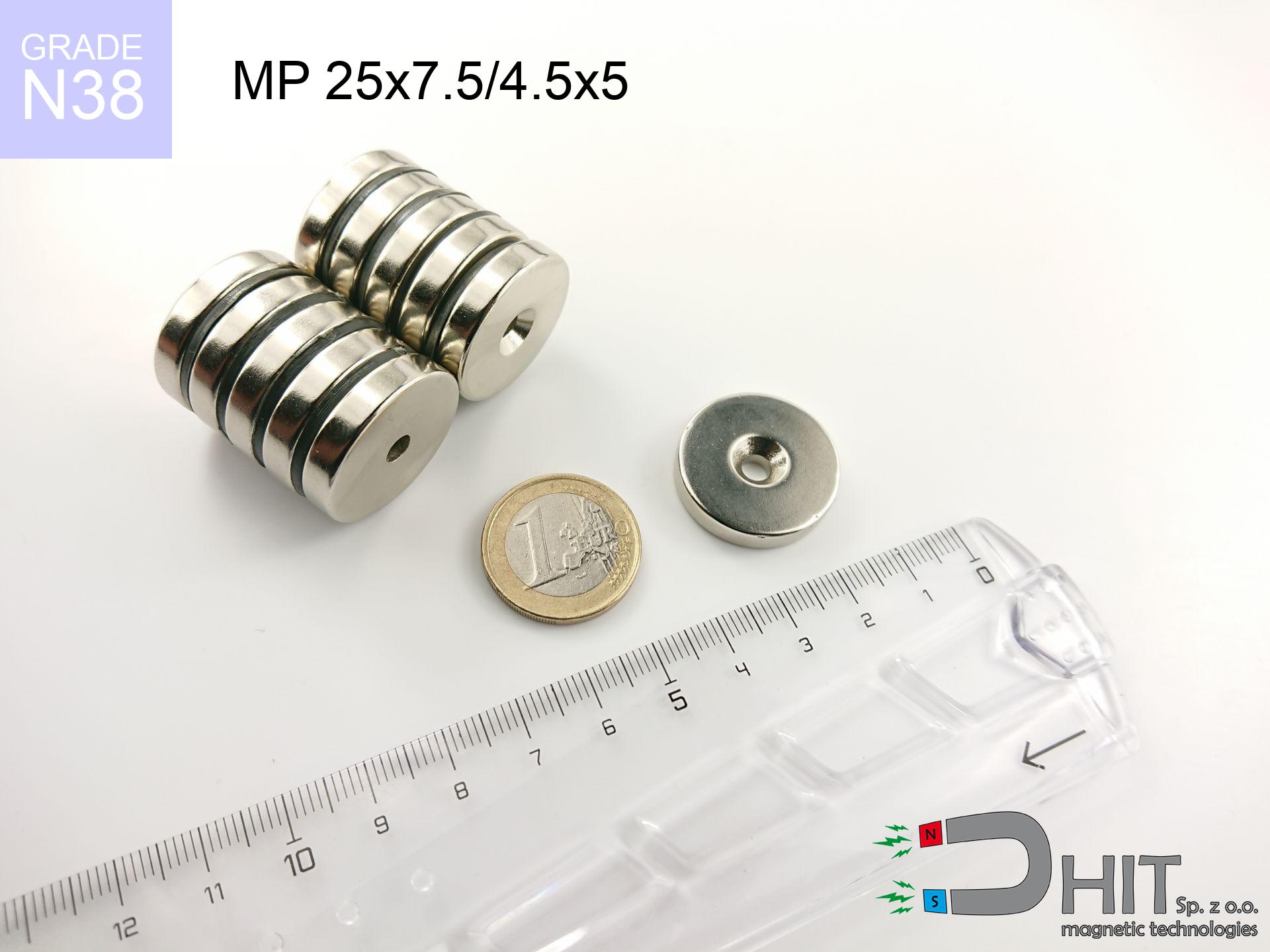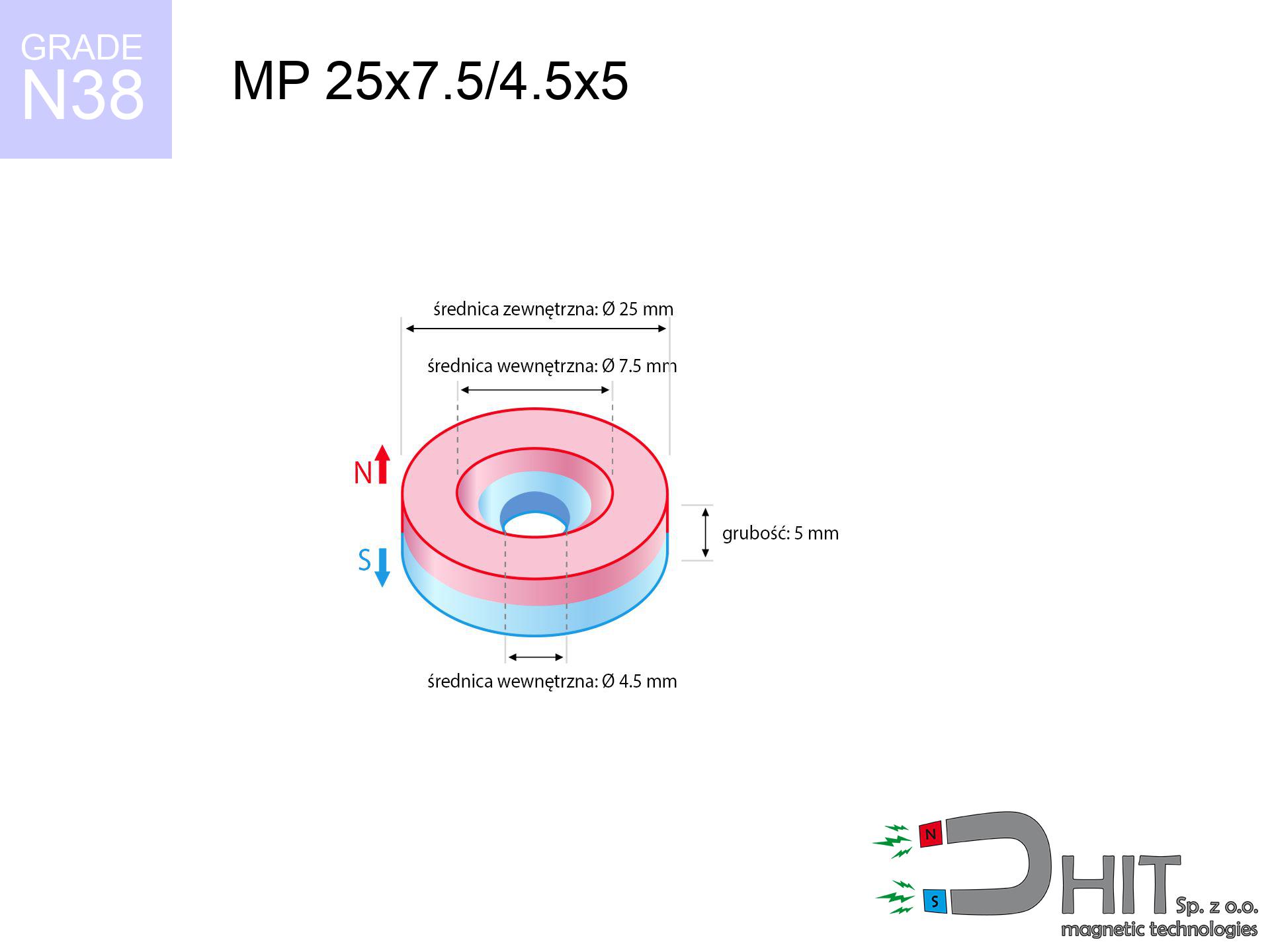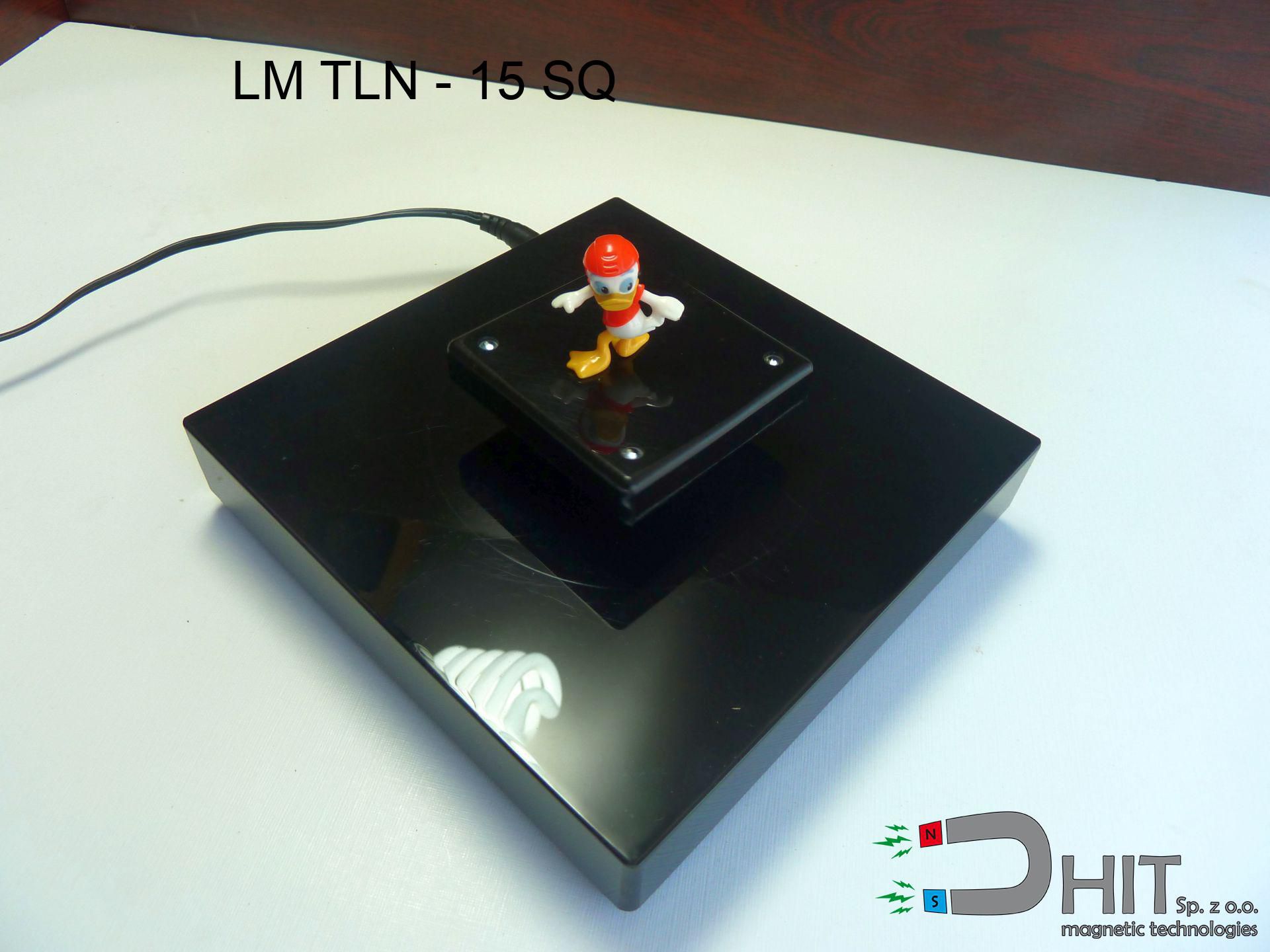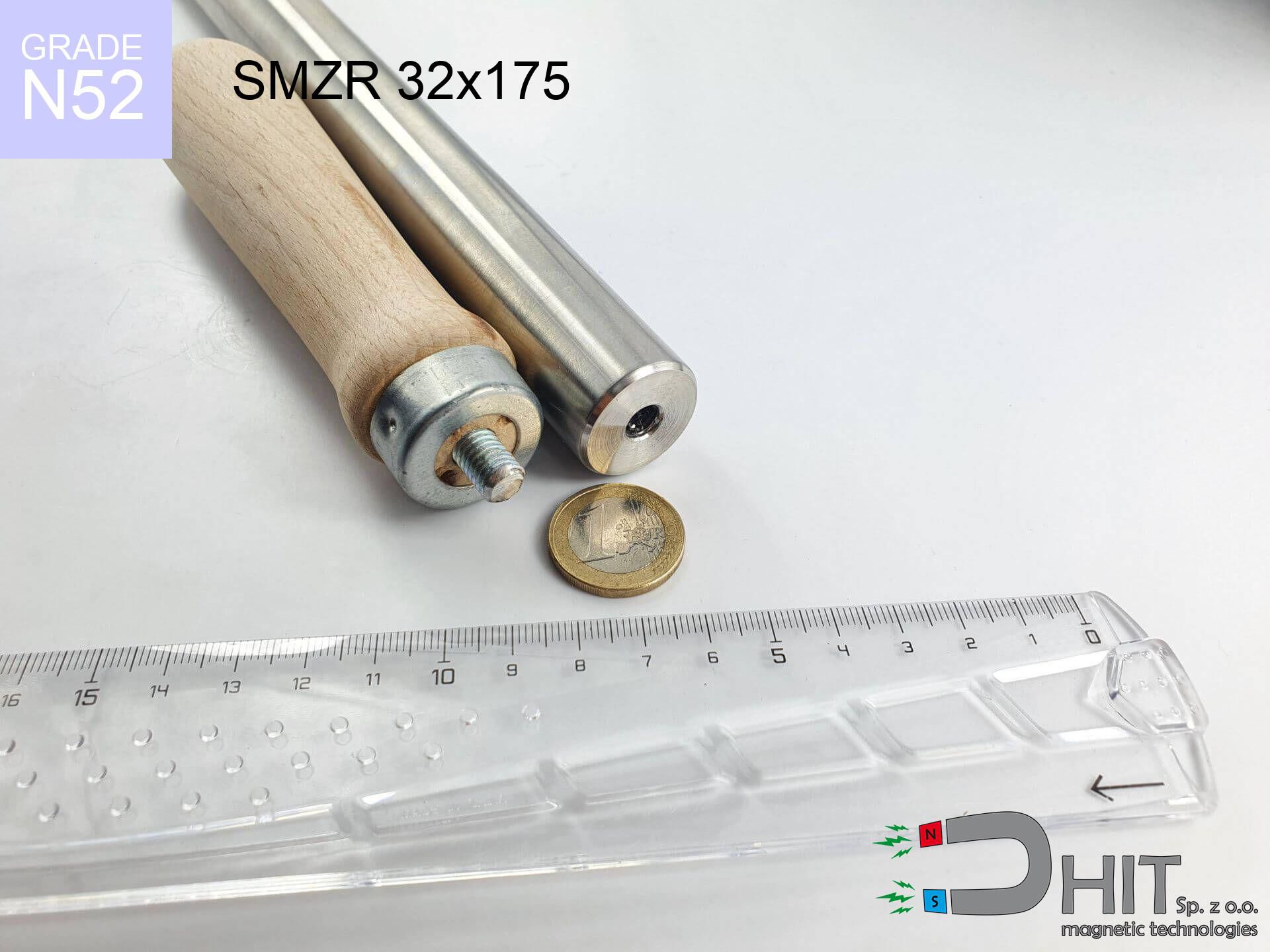MP 25x7.5/4.5x5 / N38 - ring magnet
ring magnet
Catalog no 030194
GTIN: 5906301812111
Diameter [±0,1 mm]
25 mm
internal diameter Ø [±0,1 mm]
7.5/4.5 mm
Height [±0,1 mm]
5 mm
Weight
22.38 g
Magnetization Direction
↑ axial
Load capacity
1.71 kg / 16.77 N
Magnetic Induction
333.60 mT
Coating
[NiCuNi] nickel
8.00 ZŁ with VAT / pcs + price for transport
6.50 ZŁ net + 23% VAT / pcs
bulk discounts:
Need more?Want to negotiate the price?
Call us +48 22 499 98 98 or write via form on the contact page. Test the magnet's power with our power calculator.
Orders placed by 14:00 are shipped the same day.
MP 25x7.5/4.5x5 / N38 - ring magnet
Magnetic properties of material N38
Physical properties of NdFeB
Shopping tips
Advantages and disadvantages of neodymium magnets
Neodymium magnets, also known as NdFeB magnets, are currently the strongest permanent magnets available on the market. Their exceptional magnetic properties make them suitable for various industries, technologies, and everyday life. Below are the key advantages:
- Immense attractive force: Even small neodymium magnets generate a very strong magnetic field.
- High coercivity: They are resistant to demagnetization by external magnetic fields.
- Wide operating temperature range: Standard neodymium magnets operate up to 80°C, with special versions up to 230°C.
- Variety of shapes and sizes: Available in many forms, making them easy to adapt to specific applications.
- Relatively low price compared to strength: They offer the best strength-to-price ratio among all magnets.
- Longevity: With proper use, they retain their magnetic properties for many years.
- Versatility of applications: From electric motors to speakers, separators, toys, and jewelry.
Despite numerous advantages, neodymium magnets also have certain disadvantages to consider:
- Brittleness: They are hard but brittle and prone to cracking or chipping upon impact.
- Limited operating temperature for standard versions: Above the Curie temperature, they lose their magnetic properties.
- Strong magnetic field can be dangerous: They can damage electronics, magnetic cards, and pose a risk of attracting metal objects with great force.
- Difficulties in mechanical processing: Due to their hardness and brittleness, processing them is complex.
Precautions
You should maintain neodymium magnets at a safe distance from the wallet, computer, and TV.
The strong magnetic field generated by neodymium magnets can destroy magnetic media such as floppy disks, video tapes, HDDs, credit cards, magnetic ID cards, cassette tapes, etc. devices. They can also destroy videos, televisions, CRT computer monitors. Remember not to place neodymium magnets close to these electronic devices.
The magnet is coated with nickel. Therefore, exercise caution if you have an allergy.
Studies show a small percentage of people have allergies to certain metals, including nickel. An allergic reaction often manifests as skin redness and rash. If you have a nickel allergy, you can try wearing gloves or simply avoid direct contact with nickel-plated neodymium magnets.
Under no circumstances should neodymium magnets be brought close to GPS and smartphones.
Magnetic fields can interfere with compasses and magnetometers used in aviation and maritime navigation, as well as internal compasses of smartphones and GPS devices. There are neodymium magnets in every smartphone, for example, in the microphone and speakers.
Magnets are not toys, children should not play with them.
Remember that neodymium magnets are not toys. Do not allow children to play with them. They can be a significant choking hazard. If multiple magnets are swallowed, they can attract to each other through the intestinal walls, causing significant injuries, and even death.
Neodymium magnets are among the strongest magnets on Earth. The astonishing force they generate between each other can surprise you.
Please review the information on how to handle neodymium magnets and avoid significant harm to your body, as well as prevent unintentional damage to the magnets.
People with pacemakers are advised to avoid neodymium magnets.
Neodymium magnets produce strong magnetic fields that can interfere with the operation of a heart pacemaker. However, if the magnetic field does not affect the device, it can damage its components or deactivate the device when it is in a magnetic field.
Neodymium magnets can become demagnetized at high temperatures.
Even though magnets have been observed to maintain their efficacy up to temperatures of 80°C or 175°F, it's essential to consider that this threshold may fluctuate depending on the magnet's type, configuration, and intended usage.
Magnets made of neodymium are noted for their fragility, which can cause them to crumble.
Neodymium magnets are characterized by significant fragility. Neodymium magnets are made of metal and coated with a shiny nickel surface, but they are not as hard as steel. At the moment of collision between the magnets, small metal fragments can be dispersed in different directions.
Neodymium magnets can attract to each other, pinch the skin, and cause significant swellings.
Magnets attract each other within a distance of several to around 10 cm from each other. Remember not to place fingers between magnets or alternatively in their path when attract. Depending on how huge the neodymium magnets are, they can lead to a cut or alternatively a fracture.
Dust and powder from neodymium magnets are flammable.
Avoid drilling or mechanical processing of neodymium magnets. Once crushed into fine powder or dust, this material becomes highly flammable.
Please see the article - What danger lies in neodymium magnets? You will learn how to handle them properly.







![BM 750x180x70 [4x M8] - magnetic beam BM 750x180x70 [4x M8] - magnetic beam](https://cdn3.dhit.pl/graphics/products/bm-750x180x70-4x-m8-zif.jpg)

